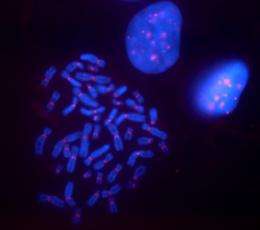Exploring the 'last frontier' of our genome

The human genome first appeared in print in 2001. But scientists aren’t done yet. There’s part of our DNA that geneticists have yet to assemble a sequence for: the centromeres.
Centromeres are necessary for chromosomes to segregate during cell division so that each new cell receives a complete copy of the genome. If chromosome segregation does not occur correctly, the resulting cells could die or become cancerous.
The sequence of centromeres remains one of the mysterious regions in the human genome because these areas are made of highly repetitive DNA sequences called satellite DNAs, said Karen Hayden, a recent graduate of Hunt Willard’s lab in Duke’s IGSP.
Centromere sequences are currently represented as gaps or spaceholders in the genome. Hayden, however, has developed a new strategy to study these elusive arrangements of DNA.
To study genomic material, scientists first break it into small pieces and sequence them. Then, much like a puzzle, they reassemble the pieces into the full sequence.
But when highly repetitive DNA, such as is found in centromeres, is broken into pieces, the parts of the puzzle look strikingly similar. As a result, scientists have trouble knowing if they have truly reassembled the pieces into the original sequence.
Using computational methods and studying the centromere sequences in the lab, however, Hayden was able to solve the puzzle and determine sequence arrangement in human centromeres. She also created a database to analyze the variations in among centromere sequences in the human genome.
Hayden said she hopes that the experiments she designed, along with the database of sequences, will provide the tools to study whether certain centromere sequences are more highly associated with diseases, such as cancer and birth defects.
This fall she will go to the Segal Lab at the Weizmann Institute in Israel to model the physical properties of centromeric sequences and study if centromeric sequences play a role in the centromere function. She then plans to continue her work in David Haussler’s lab at UC Santa Cruz.
Provided by Duke University
















